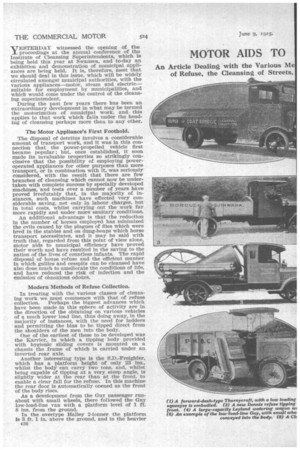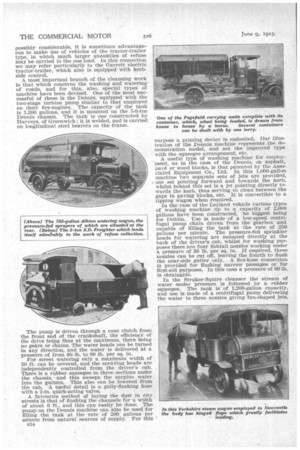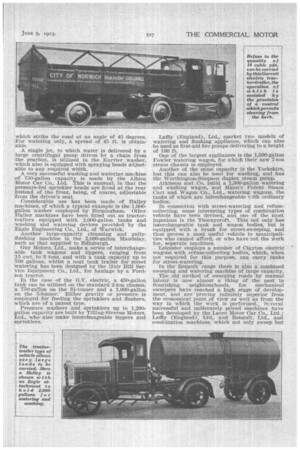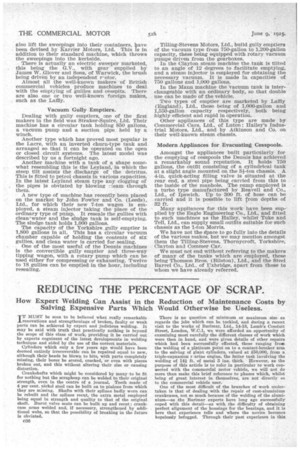MOTOR AIDS TO PAL EFFICIENCY.
Page 16

Page 17

Page 18

Page 19

Page 20

If you've noticed an error in this article please click here to report it so we can fix it.
An Article Dealing with the Various Me of Refuse, the Cleansing of Streets.
Appliances Employed in the Removal id Cesspools, and Street-watering.
YESTERDAY witnessed the opening of the proceedings at the annual conference of the Institute of Cleansing Superintendents, which is being held this year at Swansea, and to-day an exhibition and demonstration of municipal appliances are being held. It is, therefore, meet that we should deal in this issue, which will be widely circulated amongst municipal authorities, with the various appliances—motor, steam and electric— suitable for employment by municipalities, and which would come under the control of the cleansing superintendent. During the past few years there has been an extraordinary development in what may be termed the motorization of municipal work, and this applies to that work which falls under the heading of cleansing perhaps more than to any other.
The Motor Appliance's First Foothold.
The disposal of detritus involves a considerable amount of transport work, and it was in this connection that the power-propelled vehicle first became popular; but, once established, it soon made its invaluable properties so strikingly conclusive that the possibility of employing poweroperated appliances for other purposes than mere transport, or in combination with it, was seriously considered, with the result that there are few branches of cleansing which cannot now be undertaken with complete success by specially developed machines, and tests over a number of years have proved irrefutably that, in the majority of instances, such machines have effected very considerable saving, not• only in labour charges, but in total costs, whilst carrying out the work far more rapidly and under more sanitary conditions. An additional advantage is that the reduction in the number of horses employed has minimized the evils caused by the plagues of flies which were bred in the stables and on dung-heaps which horse transport necessitates, and it may be said with truth that, regarded from this point of view alone, motor aids to municipal efficiency have proved their worth and have resulted in the saving to the nation of the lives of countless infants. The rapid disposal of house refuse and the efficient manner in which gullies and cesspits can be cleansed have also done much to ameliorate the conditions of life, and have reduced the risk of infection and the emission of obnoxious odours.
Modern Methods of Refuse Collection.
In treating with the various classes of cleansing work we must commence with that of refuse collection. Perhaps the biggest advances which have been made in this sphere of activity are in the direction of the obtaining on various vehicles of a much lower load line, thus doing away, in the majority of instances, with the need for ladders and permitting the bins to be tipped direct from the shoulders of the men into the body. One of the earliest of these to be developed was the Karrier, in which a tipping body provided with hygienic sliding covers is mounted on a chassis the frame of which is carried under an inverted rear axle.
Another interesting type is the S.D.-Freighter, which has a platform height of only 23 ins., whilst the body can carry two tons, and, whilst being capable of tipping at a very steep angle, is slightly wider at the rear than at the front, to enable a clear fall for the refuse. In this machine the rear door is automatically opened as the front of the body rises. As a development from the Guy passenger runabout with small wheels, there followed the Guy low-load-line van with a platform level of 1 ft. 8 ins, from the ground. In the overtype Halley 2-tonner the platform is 3 ft. 1 in. above the ground, and in the heavier c32 models 3 ft. 3 ins. To these figures uust be added 1 ft. 3 ins, for the sides.
Amongst foreign-built vehicles of this type there are the Renault, Latil and fl-viss Berna, the Renault having hinged flaps at the side, which can be raised as the contents increase.
A similar method of reducing the height of the sides is utilized in certain Dennis vehicles, such as that supplied to Plymouth, in which the sides are 2 ft. high, and the upper 6 ins. o1 each forms a hinged flap in three sections, which gives a loading height, when down, of 5 ft. from the road surface, whilst the wheel arches are taken into the body, and a roof consisting of six curved sliding covers is employed. At this juncture it will be of interest to refer to the latest Dennis vehicle of the low type, which has been built for Southwark. The body has a capacity of 6i cubic yds., whilst the loading height is 4 ft. 8 ins, to the top. It is equipped with a hand-operated tipping gear, and to facilitate the egress of the nyfuse the body is wider by 6 ins, at the rear than at the front. In this case, also, the wheel arches are taken into the body and are so curved as to impede the rubbish but little.
The idea of utilizing hinged half-sides has also been used successfully on the Yorkshire steam wagon, particularly In the service of the Newcastle-upon-Tyne Corporation, in certain vehicles produced at the Leyland works, and in the standard 34-ton Orwell electric.
Low-load line is also a quality a the Carrimore and Eagle trailers employed in conjunction with the Fordson tractor. Another trailer specially designed for the work of refuse collection is that built by Martin and Co., of Redhill, Denham, 'Uxbridge.
The Sphere of the Battery Electric.
The electric vehicle is proving very popular ludeed in this class of work, for which it is ideally suited, and may be considered as he direct competitor of the horse. There should be a considerable future for it, as even now approximately half of the total collecting work is still done by horses which, in most cases, could nrofitably be replaced. The collection and disposal of refuse in England and Wales alone are by no means a small item in our communal life. It actually costs nearly £8,000,000 annually, gives employment to 34,000 men and deals with some 11,000,000 tons of solid waste.
A late development in the employment of the electric vehicle is kerbside control, which permits the driver to manipulate the vehicle without haying to enter the cab—a considerable advantage where the number of stops in collecting a ton of material may be something over 50.
Combined Horse and Power Systems.
We cannot leave the subject of refuse coilection without referring briefly to the very interesting systems devised to make use of the advantages of the horse and the power-driven appliance. Perhaps the best known of these is the Pagefield. in which horse-drawn containers are, when loaded, transported to the dumps or destructors on motor vehicles, being hauled into position by a winch and carried on a tipping frame. The makers of the apparatus are Walker Bros. (Wigan). Ltd. Somewhat resembling this is the idea used in the Milnes-Daimler outfit, except that in this case use is made of a telescopic runway.
The Eagle Engineering Co., Ltd., of Warwick, also provide sets of Eagle trailer containers, which can be employed in conjunction with the Fordson tractor, and may be horse-drawn forfilIing purposes.
Where the quantities of refuse which have to be handled are large and the distance to the dump possibly considerable, it is sometimes advantageous to make use of vehicles of the tractor-trailer type, in which much larger quantities of refuse may be carried in the one load. In this connection we may refer particularly to the Garrett electric tractor-trailer, which also is equipped with kerbside control.
A most important branch of the cleansing work Is that which concerns the washing and watering of roads, and for this, also, special types of machine have been devised. One of the most successful of these is the Dennis, equipped with the two-stage turbine pump similar to that employed on their fire-engines. The capacity of the tank is 1,200 gallons, and it is mounted on the 5-6-ton Dennis chassis. The tank is one constructed by Harveys, of Greenwich ; it Is welded, and Is carried on longitudinal steel bearers on the frame.
The pump Is driven through a cone clutch from the front end of the crankshaft, the efficiency of the drive being thus at the maximum, there being no gears or chains. The water heads can be turned in any direction, and the water is delivered at a pressure of from 60 lb. to 80 lb. per sq. in.
For street watering only a maximum width of 50 ft. can be covered, and the spraying heads are independently controlled from the driver's cab. There is a rubber squeegee in three sections under the chassis, and this sweeps, the surplus water Into the gutters. This also can be lowered from the cab. 'A useful detail is a gully-flushing hose with a 2-in, quick-acting valve.
A favourite method of laying the dust in city streets is that of flushing the channels for a width of about 6 ft., and this can easily be done. The pump on the Dennis machine can also be used for filling the tank at the rate of 200 gallons per minute from natural sources of supply. For this purpose a priming device is embodied, Our illustration of the Dennis machine represents the demonstration model, and not the improved type with the squeegee arrangement, etc. A useful type of washing machine for employment, as in the case of the Dennis, on asphalt, pave or wood blocks, is that patented by the Associated Equipment Co., Ltd. In this 1,000-gallon machine two separate sets of jets are provided, one set pointing forward and towards the kerb, whilst behind this set is a jet pointing directly towards the kerb, thus serving to clean between the gaps in paving blocks, etc. It is convertible to a tipping wagon when required.
In the case of the Leyland vehicle various types of washing machine up to a capacity of 2,000 gallons have been constructed, he biggest being for Dublin. Use is made of a low-speed centrifugal pump chain driven from the gearbox and capable of filling the tank at the rate of 250 gallons per minute. The pressure-fed sprinkler heads for watering are mounted directly at the back of the driver's cab, whilst for washing purposes there are four fishtail nozzles working under a pressure of 30 lb. per sq. in. If required, three nozzles can be cut off, leaving the fourth to flush the near-side gutter only. A fire-hose connection is provided for flushing narrow passages or for first-aid purposes In this case a pressure of 60 lb. is obtainable.
In the Straker-Squire cleanser the stream of water wader pressure is followed by a rubber squeegee. The tank is of 1,200-gallon capacity, and use is made of a centrifugal pump delivering the water to three nozzles giving fan-shaped jets,
which strike the road at an angle of 45 degrees. For watering only, a spread of 45 ft. is obtainable.
A single jet, to which water is delivered by a large centrifugal pump driven by a chain from the gearbox, is utilized in the Earlier washer, which also is equipped with spraying heads adjustable to any required width.
A very successful washing and waterin.v. machine of 750-gallon capacity is made by the Albion Motor Car Co., Ltd. This is unusual, in that the pressure-fed sprinkler heads are fitted at the rear instead of the front, being, of course, adjustable from the driver's seat.
Considerable use has been made of Halley machines, of which a typical example is the 1,000gallon washer employed by Birmingham. Other Halley machines have been fitted out as tractortrailers equipped with 2,000-gallon tanks and washing and watering devices provided by the Eagle Engineering Co., Ltd., of Warwick. Another large-capacity cleansing and gullyflushing machine is the 2,000-gallon Maudslay, such as that supplied to Edinburgh_ . Guy Motors, Ltd., make a series of interchangeable tank wagons and tippers, ranging from 15 cwt. to 3 tons, and with a .tank capacity up to 700 gallons, whilst a neat tank trailer for street Watering has been designed by the Muir Hill Service Equipment Co., Ltd., for haulage by a Fordson tractor.
In the case of the G.V. electric, a 450-gallon tank can be utilized on the standard 2-ton chassis, a 750-gallon on the 3i-tonner and a 1,000-gallon on the 5-tonner. Either gravity or pressure is employed for feeding the sprinklers and ilushers, which are of a patent type.
Pressure washers and sprinklers up to 1,200gallon capacity are built by Tilling-Stevens Motors, Ltd., "-who also make interchangeable tippers and Sprinklers. Lathy (England), Ltd., market two models of watering and flushing appliance, which can also be used as first-aid fire pumps delivering to a height of 180 ft.
One of the. largest appliances is the 1,500-gallon Fowler watering wagon, for which their new 7-ton steam chassis is employed.
Another of the same capacity is the Yorkshire, but this can also be used for washing, and has the Worthington-Simpson duplex steam pump. Atkinson and. Co. build a 1,300-gallon watering and waShing wagon, and Mann's Patent Steam Cart and Wagon Co, Ltd., watering wagons, the tanks of which are interchangeable with ordinary bodies.
In connection with street-watering and refusecollecting, some interesting types of combination -vehicle have been devised, and one of the most ingenious is the Thornycroft. This not only has interchangeable tank and wagon bodies, but is equipped with a brush for street-sweeping, and thus proves a most useful vehicle to municipalities who cannot afford, or who have not the work for, separate machines.
Leicester employs a number of Clayton electric wagons with refuse-collecting bodies, which, when not required for this purpose, can carry tanks for street-watering.
In the Renault range there Is also a combined sweeping and watering machine of large capacity. The old method of sweeping roads by manual labour is now almost a thing of the past in flourishing neighbourhoods, for mechanical sweepers have reached a high stage of _development, and are proving infinitely superior from the. economical point of view as well as from the way in which the Work is perfOrTried:, "Several successful and mOderately. priced Machine have been developed by the. Lacre Motor Car Co., Ltd.; Laffly (England), Ltd., and Renault, Ltd., and combination machines,' which not only sweep but also lift the sweepings into their containers, liaave been devised by Karrier Motors, Ltd. This is in addition to their standard machine, which throws the sweepings into the kerbside.
There is actually an electric sweeper marketed, this being the G.V., with gear supplied by James W. Glover and Sons, of Warwick, the brush being drivei . by an independent r-otor.
Almost all the well-known makers of British commercial vehicles produce machines to deal with the emptying of gullies and cesspits. There are also one or two well-known foreign makes, such as the Laffly.
Vacuum Gully Emptiers.
Dealing with gully emptiers, one of the first makers in the field was Straker-Squire, Ltd. Their machine has a circular tank holding 850 gallons, a vacuum pump and a suction pipe held by a winch.
Another type which has proved most popular is the Lacre, with an inverted churn-type tank and arranged so that it can be operated on the open or closed circuit systems. The latest model was described by us a fortnight ago.
Another machine with a tank of a shape somewhat resembling this is the Leyland, in which the steep tilt assists the discharge of the detritus. This is fitted to petrol chassis in various capacities. In the latest Leyland steam type any clogging of the pipes is obviated by blowing -team through them.
A new type of machine has recently been placed on the market by John Fowler and Co. (Leeds), Ltd., for which their new 7-ton wagon is employed, a steam injector taking the place of the ordinary type of pump. It reseals the gullies with cleanwater and the sludge tank is self-emptying. The sludge tank holds 1.000 gallons.
The capacity of the Yorkshire gully emptier is•1,800 gallons in all. This has a circular vacuum
chamber capable of holding the contents of six gullies, and clean water is carried for sealing. One of the most useful of the Dennis machines is the convertible gully emptier and three-way tipping wagon, with a rotary pump which can be used either for compressing or exhausting. Twelve to 1.8 gullies can be emptied in the hour, including resealing. Tilling-Stevens Motors, Ltd., build gully emptiers of the vacuum type from 750-gallon to 1,200-gallon capacity, these being equipped with rotary vacuum pumps driven from the gearboxes.
In the Clayton steam machine the tank is tilted to an angle of 12 degrees to facilitate emptying, and a steam injector is employed for obtaining the necessary vacuum. It is made in capacities of 750 gallons and 1,000 gallons.
In the Mann machine the vacuum tank is interchangeable with an ordinary body, so that double use can be made of the vehicle.
Two types of emptier are marketed by Lafily (England), Ltd., these being of 1,000-gallon and 1,550-gallon capacity respectively, both being highly efficient and rapid in operation.
Other appliances of this type are made by Commercial Cars, Ltd., of Luton ; Halley's Industrial Motors, Ltd., and by Atkinson and Co on their well-known steam chassis.
Modern Appliances for Evacuating Cesspools.
Amongst the appliances built particularly for the emptying of cesspools the Dennis has achieved a remarkably sound reputation. It holds 750 gallons, the outfit consisting of a cylindrical tank at a slight angle mounted on the 31--ton chassis. A 4-in, quick-acting filling valve is situated at the rear end, a steel pipe being carried from this to the inside of the manhole. The pump employed Is a turbo type manufactured by Reavell and Co., Ltd., of Ipswich. Up to 300 ft. of hose can be carried and it is possible to lift from depths of 32 ft.
Many appliances for this work have been supplied by the Eagle Engineering Co., Ltd., and fitted to such machines as the Halley, whilst Tuke and Tell, Ltd., can supply small outfits suitable for such chassis as the 1-ton Morris.
We have not the pace to go fully into the details of the various makes, but we may mention amongst them the Tilling-Stevens, Thornycroft, Yorkshire, Clayton and Commer Car.
We must not end without referring to the makers of many of the tanks which are employed, these being Thomson Bros. (Bilston), Ltd., and the Steel Barrel Co., Ltd„ of Uxbridge, apart from those to whom we have already referred,






























